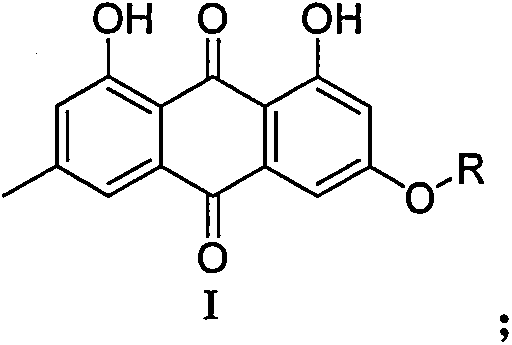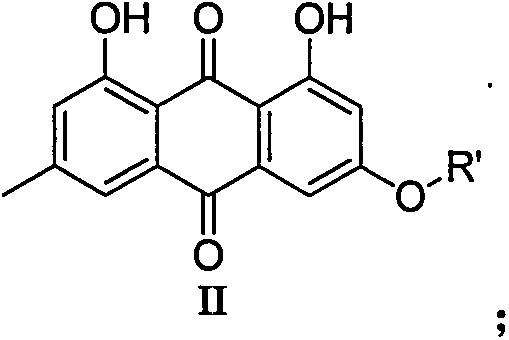1,8-dihydroxyl-9,10-anthraquinone derivative and preparation method and application thereof
A technology of anthraquinone derivatives and dihydroxyl, which is applied in 1 field, can solve the problems of general strength of action and increased activity, and achieve good anti-HCV activity effect
- Summary
- Abstract
- Description
- Claims
- Application Information
AI Technical Summary
Problems solved by technology
Method used
Image
Examples
Embodiment 1
[0041] Dissolve 5mmol emodin in 15mL tetrahydrofuran, add 10mmol triethylamine and 10mmol p-toluenesulfonyl chloride, react at room temperature for 5 hours, distill off the solvent under reduced pressure, add 15mL water, then extract three times with 15mL ethyl acetate, combine the organic phases, 15mL After washing once with water, compound 1 was obtained by column chromatography (PE / EA=4 / 1), with a yield of 59%.
[0042] 1 H NMR (500MHz, CDCl 3 )δ12.17(s, 1H), 11.88(s, 1H), 7.79(d, J=6.5Hz, 2H), 7.63(s, 1H), 7.44(s, 1H), 7.36(d, J=6.5 Hz, 2H), 7.11(s, 1H), 7.00(s, 1H), 2.46(s, 6H, overlapped); 13 C NMR (126MHz, CDCl 3 )δ191.5, 180.7, 163.88, 162.9, 155.5, 149.7, 146.2, 135.3, 132.8, 132.1, 130.1, 128.4, 124.7, 121.7, 117.0, 114.7, 113.8, 113.4, 22.2, 21.7; ESI-MS: 422.9[M-H] - .
Embodiment 2
[0044] Dissolve 5mmol emodin in 15mL acetone, add 10mmol potassium carbonate and 15mmol methyl chloroformate, heat up to 45°C for 12 hours, distill off the solvent under reduced pressure, add 15mL water, then extract three times with 15mL ethyl acetate, and combine the organic phases , washed once with 15 mL of water, and column chromatography (PE / EA=4 / 1) gave Compound 1 with a yield of 65%.
[0045] 1 H NMR (500MHz, CDCl 3 )δ12.21(s, 1H), 11.95(s, 1H), 7.66(s, 1H), 7.64(d, J=2.5Hz, 1H), 7.15(d, J=2.0Hz, 1H), 7.18( d, J=1.0Hz, 1H), 3.96(s, 3H), 2.47(s, 3H); 13 CNMR (126MHz, CDCl 3 )δ191.5, 181.1, 164.1, 162.8, 157.1, 152.8, 149.4, 135.2, 133.0, 124.7, 121.7, 115.9, 114.0, 113.5, 113.2, 55.9, 22.2; ESI-MS: m / z 329.2 [M+H] + ;351.1[M+Na] + ;326.9[M-H] - .
Embodiment 3
[0047] Dissolve 5mmol of emodin in 15mL of acetone, add 10mmol of potassium carbonate and 15mmol of 4-methoxybenzyl chloride, heat up to 45°C for 12 hours, distill off the solvent under reduced pressure, add 15mL of water, and extract three times with 15mL of ethyl acetate. The organic phases were combined, washed once with 15 mL of water, and subjected to column chromatography (PE / EA=4 / 1) to obtain Compound 1 with a yield of 53%.
[0048] 1 H NMR (500MHz, CDCl 3 )δ12.29(s, 1H), 12.11(s, 1H), 7.62(s, 1H), 7.44(d, J=2.5Hz, 1H), 7.37(d, J=8.5Hz, 2H), 7.08( s, 1H), 6.94(d, J=8.5Hz, 2H), 6.75(d, J=2.5Hz, 1H), 5.12(s, 2H), 3.83(s, 3H), 2.45(s, 3H); 13 C NMR (126MHz, CDCl 3 )δ190.8, 182.0, 165.7, 165.1, 162.5, 159.8, 148.4, 135.2, 133.2, 129.4, 127.3, 124.5, 121.3, 120.0, 114.2, 113.7, 110.3, 108.8, 107.7, 10.2, 95.3 - MS: m / z 389.1 [M-H] - .
PUM
 Login to View More
Login to View More Abstract
Description
Claims
Application Information
 Login to View More
Login to View More - R&D
- Intellectual Property
- Life Sciences
- Materials
- Tech Scout
- Unparalleled Data Quality
- Higher Quality Content
- 60% Fewer Hallucinations
Browse by: Latest US Patents, China's latest patents, Technical Efficacy Thesaurus, Application Domain, Technology Topic, Popular Technical Reports.
© 2025 PatSnap. All rights reserved.Legal|Privacy policy|Modern Slavery Act Transparency Statement|Sitemap|About US| Contact US: help@patsnap.com



